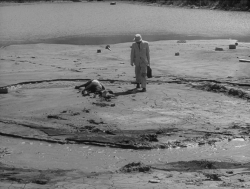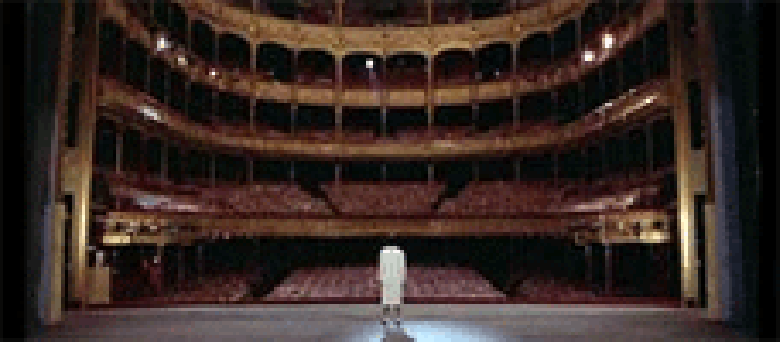Reviews
Jean-Jacques Beineix
France, 1981
Credits
Review by Victoria Large
Posted on 28 February 2008
Source Rialto Pictures 35mm print
Early in director Jean-Jacques Beineix’s Diva, elegant American opera singer Cynthia Hawkins - played by elegant American opera singer Wilhelmenia Fernandez - gives a rousing performance in a subtly decaying Parisian theater. It’s a neat evocation of transcendent art in a less than transcendent world, and as befits a film about the creation and consumption of art, this one is a sensory feast.
There are, of course, Fernandez’s powerful vocals, and Beineix’s much-acclaimed visuals have just the right free-associative charm. From the junkyard-chic apartment of the film’s young hero Jules, its walls covered in pop art depictions of horrid tragedies (A precursor to the “Disasterology” calendar from Michel Gondry’s The Science of Sleep, perhaps?), to a lighthouse rising dark against a deep blue sky, the locations are fresh and have a touch of the surreal. Regardless of how much of it that you attempt to decode (Is there a metaphor hiding in that enormous jigsaw puzzle of an ocean wave?); Diva is a pleasure to simply absorb.
The funky plot that manages to involve the opera-obsessed Jules with a corrupt cop, Taiwanese bootleggers, and a prostitution ring is easy to get lost in, but I find myself glad that it’s there, if only as something to rein Beineix in and keep the film from collapsing under the weight of too many froufrou impulses indulged. It also provides a fine excuse for Diva’s buzz-worthy action setpiece—an extraordinary chase sequence through a Métro station that would have kept the film in memory for some time even if there weren’t ample other reasons to enjoy and examine it.
And there is indeed more here to examine than a lot of pretty pictures and sounds, though the film’s undeniable stylistic flash has overwhelmed some critical reactions to it. In his 1982 review of the film, Vincent Canby writes of Diva as “an empty though frightfully chic-looking film,” dismissing it as having “the self-consciously enigmatic manner of a high-fashion photograph, the kind that’s irresistible to amateur artists who draw mustaches on the perfectly symmetrical faces of pencil-thin models in sables.”
What I think Canby misses it that Diva does have something to say, particularly when it explores the symbiotic relationship between artist and audience. Jules, a dedicated fan of Hawkins’ work, makes illegal bootlegs of her concerts for his own use because his favorite artist is insistent that her music is meant to be evanescent, and refuses to record. Though Jules’ intent is never malicious, his actions do carry a seedy undercurrent. In an interview scene, Hawkins compares bootlegging with theft and rape. Juxtaposed with a scene in which Jules asks a prostitute to wear a dress that he’s stolen from Hawkins, her words have weight. Haunting these scenes is the question of when devotion becomes violation.
Certain aspects of Diva’s plotting ring quaint more than twenty-five years on—not only that the story’s intrigue is strictly of the analog variety, with its sought-after cassette tapes, but also that Hawkins is able to exercise so much control over the distribution of her work. (It’s easy to imagine that today Hawkins would be a Youtube staple, the low-fi video reducing her body to a shapeless dot and her voice to a garble.) But the breakdown of the systems that used to make art less accessible but more exalted, not to mention our ever-increasing focus on celebrity, only makes the film feel more relevant, not less. Jules’ theft of Hawkins’ dress - and her performance - speaks of a desire to possess the people we revere, that weird sense of entitlement we have when it comes to public figures.
Yet one of Diva’s twists is that never devolves into a simple story of spiraling obsession. In fact, Beineix’s film celebrates the role of the audience member as much as he does that of the artist. Jules avoids becoming a full-fledged scary creep, instead maintaining an air of naïve enthusiasm and our sympathies as well. For him, this is largely a story about growing up. And for her part, Hawkins is flattered by Jules’ admiration and confesses that she has not recorded because she cannot perform without an audience. The image that we get late in the picture, of the singer, alone onstage before rows upon rows of empty seats, says it all: there are no divas without patrons to fill the house. How appropriate, then, the film concludes with nothing more than the sound of soaring opera over a darkened screen, preceded by a simple instruction: “Listen…”
We don’t do comments anymore, but you may contact us here or find us on Twitter or Facebook.



